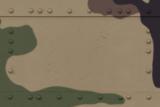Depleted Uranium
Radiation Facts
- Depleted uranium is used for tank armor, armor-piercing bullets, and as weights to help balance aircrafts.
- Depleted uranium is both a toxic chemical and radiation health hazard when inside the body.
Depleted uranium (DU) is the material left after most of the highly radioactive form of uranium (U-235) is removed from the natural uranium ore. DU has several common uses.
About Depleted Uranium
Naturally occurring uranium ore is abundant in nature and contains several forms of uranium called isotopes. All uranium isotopes are radioactive; however, only one of these isotopes, Uranium-235 (U-235), provides the fuel used to produce both nuclear power and the powerful explosions used in nuclear weapons.
In nature, U-235 only makes up a very small part of the uranium ore. Given its importance for nuclear power and nuclear weapons technology, U-235 is often removed from the natural uranium ore and concentrated through a process called uranium enrichment. DU is the material left behind after enrichment. Like the natural uranium ore, DU is radioactive. DU mainly emits alpha particle radiation. Alpha particles don't have enough energy to go through skin. As a result, exposure to the outside of the body is not considered a serious hazard. However, if DU is ingested or inhaled, it is a serious health hazard. Alpha particles directly affect living cells and can cause kidney damage.
In the 1970s, the U.S. Department of Defense (DOD) began making bullets and mortar shells out of DU given its high density. DU was also used to create armor for tanks and as weights to balance aircrafts. The U.S. Department of Energy (DOE) was operating facilities that produced DU as a waste byproduct, making DU plentiful and inexpensive.
DU is still used to make bullets and mortar shells. DU contamination of spent shells and shell fragments is a hazard at some military firing ranges.
What you can do
Avoid facilities that use or process DU: DU is dangerous when it is inside your body.
Avoid internal exposure: If DU gets inside the body the hazards increase. Minimize your risk of internal exposure by limiting your proximity to uranium manufacturing plants and firing ranges that continue to use DU in ammunition.

